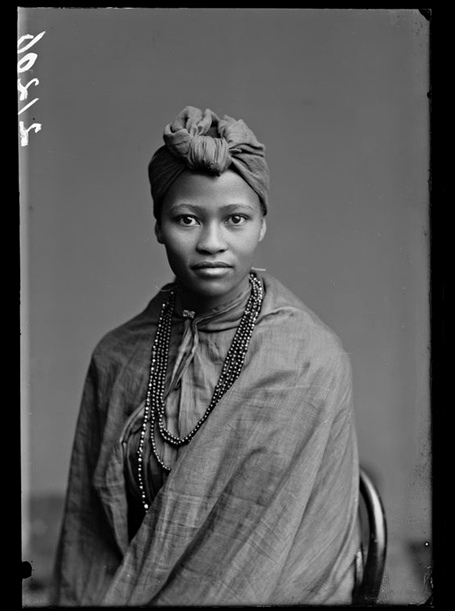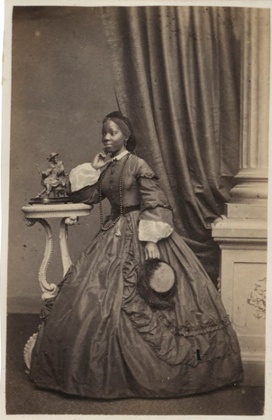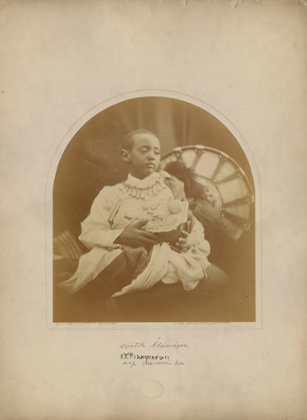
BLACK CHRONICLES II
 John Xiniwe and Albert Jonas, London Stereoscopic Company studios, 1891. Courtesy of © Hulton Archive/Getty Images
John Xiniwe and Albert Jonas, London Stereoscopic Company studios, 1891. Courtesy of © Hulton Archive/Getty Images
 Eleanor Xiniwe, The African Choir, 1891-93. London Stereoscopic Company. Courtesy of © Hulton Archive/Getty Images
Eleanor Xiniwe, The African Choir, 1891-93. London Stereoscopic Company. Courtesy of © Hulton Archive/Getty Images Unidentified sitter, c. 1881. Missionary Leaves Association. Courtesy Paul Frecker collection / The Library of Nineteenth Century Photography
Unidentified sitter, c. 1881. Missionary Leaves Association. Courtesy Paul Frecker collection / The Library of Nineteenth Century Photography Saragano Alicamousa, renowned lion and tiger tamer, c. 1870s. Courtesy Michael Graham-Stewart collection
Saragano Alicamousa, renowned lion and tiger tamer, c. 1870s. Courtesy Michael Graham-Stewart collection Mussa Bhai, The Salvation Army, 1890. London Stereoscopic Company studios. Courtesy of © Hulton Archive/Getty Images
Mussa Bhai, The Salvation Army, 1890. London Stereoscopic Company studios. Courtesy of © Hulton Archive/Getty Images Peter Jackson, 1889. London Stereoscopic Company. Courtesy of © Hulton Archive/Getty Images
Peter Jackson, 1889. London Stereoscopic Company. Courtesy of © Hulton Archive/Getty Images Unidentified sitters, c. 1870s. Courtesy Paul Frecker Collection
Unidentified sitters, c. 1870s. Courtesy Paul Frecker Collection Dhuleep Singh, c. 1864. Courtesy Jenny Allsworth collection
Dhuleep Singh, c. 1864. Courtesy Jenny Allsworth collection Rivington Place, London
Rivington Place, London
BLACK CHRONICLES II
12 SEPTEMBER – 29 NOVEMBER 2014
RIVINGTON PLACE
LONDON, UK
Free exhibition
Autograph ABP presents Black Chronicles II, a new exhibitionexploring black presences in 19th and early 20th-century Britain, through the prism of studio portraiture – continuing our critical mission of writing black photographic history.
Drawing on the metaphor of the chronicle the exhibition presents over 200 photographs, the majority of which have never been exhibited or published before. As a curated body of work, these photographs present new knowledge and offer different ways of seeing the black subject in Victorian Britain, and contribute to an ongoing process of redressing persistent ‘absence’ within the historical record.
Many of the images on display have very recently been unearthed as part of our current archive research programme, The Missing Chapter – a three-year project supported by the Heritage Lottery Fund. This is the second exhibition in a series dedicated to excavating archives, which began with ‘The Black Chronicles’ in 2011.
Black Chronicles II is a public showcase of Autograph ABP’s commitment to continuous critical enquiry into archive images which have been overlooked, under-researched or simply not recognised as significant previously, but which are highly relevant to black representational politics and cultural history today. For the first time acomprehensive body of portraits depicting black people prior to the beginning of the second world war are brought together in this exhibition – identified through original research carried out in the holdings of national public archives and by examining privately owned collections. This research also coincides with Autograph ABP’s continuous search for the earliest photographic image of a black person created in the UK.
All of the photographs in the exhibition were taken in photographic studios in Britain prior to 1938, with a majority during the latter half of the 19th century. Alongside numerous portraits of unidentified sitters, the exhibition includes original prints of known personalities, such as Sarah Forbes Bonetta, goddaughter to Queen Victoria; Prince Alemayehu, photographed by renowned photographer Julia Margaret Cameron; or Kalulu,African ‘boy servant’ (companion) to the British explorer Henry Morton Stanley.
This extensive display of over 100 original carte-de-visite is drawn from several collections, and presented in dialogue with Autograph ABP’s 1996 commission ‘Effnik’ by Yinka Shonibare MBE.
A highlight of the show is a dedicated display of thirty portraits of members of The African Choir, who toured Britain between 1891-93, seen here for the first time. Perhaps the most comprehensive series of images rendering the black subject in Victorian Britain, these extraordinary portraits on glass plate negatives by the London Stereoscopic Company have been deeply buried in the Hulton Archive, unopened for over 120 years. These are presented alongside those of other visiting performers, dignitaries, servicemen, missionaries, students and many as yet unidentified black Britons. Their presence bears direct witness to Britain’s colonial and imperial history and the expansion of Empire.
‘They are here because you were there. There is an umbilical connection. There is no understanding Englishness without understanding its imperial and colonial dimensions.’ Stuart Hall, 2008
The exhibition is dedicated to the memory of Stuart Hall (1932-2014). It features text and audio excerpts from his keynote speech on archives and cultural memory, held at Rivington Place in May 2008.
‘The curatorial premise of Black Chronicles II is to open up critical enquiry into the archive, continue the debate around black subjectivity within Britain, examine the ideological conditions in which such photographs were produced and the purpose they serve as agents of communication.’ Curators’ note
Black Chronicles II also marks the 30th anniversary of the publication of Peter Fryer’s seminal book Staying Power: The History of Black People in Britain (1984).
>via: http://autograph-abp.co.uk/exhibitions/black-chronicles-ii
__________________________
![]()
The black Victorians:
astonishing portraits
unseen for 120 years
From the African Choir posing like Vogue models to an Abyssinian prince adopted by an explorer, a new exhibition spotlights the first black people ever photographed in Britain

Discovered … Member of the African Choir, London Stereoscopic Company, 1891. Photograph: Courtesy of © Hulton Archive/Getty Images
The African Choir were a group of young South African singers that toured Britain between 1891 and 1893. They were formed to raise funds for a Christian school in their home country and performed for Queen Victoria at Osborne House, a royal residence on the Isle of Wight. At some point during their stay, they visited the studio of the London Stereoscopic Company to have group and individual portraits made on plate-glass negatives. That long-lost series of photographs, unseen for 120 years, is the dramatic centrepiece of an illuminating new exhibition called Black Chronicles II.
“The portraits were last shown in the London Illustrated News in 1891,” says Renée Mussai, who has co-curated the show at London’s Rivington Place alongside Mark Sealy MBE, director of Autograph ABP, a foundation that focuses on black cultural identity often through the use of overlooked archives. “The Hulton Archive, where they came from, did not even know they existed until we uncovered them while excavating their archive as part of my PhD project.”
The London Stereoscopic Company specialised in carte de visites – small photographs printed on cards that were often traded by collectors or used by performers for publicity purposes – and, as their name suggests, they were all in stereo which, when seen through a special viewer, gave the illusion of a three-dimensional photograph.
The enlarged portraits of the African Choir, which line one wall of the exhibition, were made by Mike Spry, a specialist in printing from glass plates who was coaxed out of retirement to undertake the meticulous process in his garden shed. They are arresting both for the style and assurance of the sitters – some of the women look like they could be modelling for Vogue – and for the way they challenge the received narrative of the history of black people in Britain.
“Black Chronicles II is part of a wider ongoing project called The Missing Chapter,” says Mussai, “which uses the history of photography to illuminate the missing chapters in British history and culture, especially black history and culture. There is a widespread misconception that black experience in Britain begins with the arrival of the Empire Windrush and the first Jamaican immigrants in 1948, but, as this exhibition shows, there is an incredible archive of images of black people in Britain that goes right back to the invention of photography in the 1830s.”
Near the African choir shots, there is an equally striking portrait of Major Musa Bhai, a Ceylon-born Muslim who was converted to Christianity in colonial India. He accompanied the family of William Booth, founder of theSalvation Army, to England in 1888 as a high-profile advocate for the organisation. As Mussai notes, there “are several intertwining narratives – colonial, cultural and personal – embedded in these images, but what is often startling is how confident and self-contained many of the sitters are as they occupy the frame.”

Sara Forbes Bonetta. Brighton, 1862. Photograph: Courtesy of Paul Frecker collection/The Library of Nineteenth-Century Photography
Black Chronicles II is punctuated by several such surprising shots, some of well-known people but many of ordinary individuals caught up in the indiscriminate sweep of colonial and postcolonial history. Among the former is Sara Forbes Bonetta, perhaps the most celebrated black British Victorian, who was photographed by two pre-eminent portrait photographers, Camilla Silvy and Julia Margaret Cameron.
Captured aged five by slave raiders in west Africa, Forbes Bonetta was rescued by Captain Frederick E Forbes, then presented as a “gift” to Queen Victoria. Forbes, who rechristened the child after his ship, the Bonetta, later wrote of the proud moment when he realised that Forbes Bonetta “would be a present from the King of the Blacks to the Queen of the Whites.”

Prince Alamayou. Isle of Wight,1868. Photograph: Julia Margaret Cameron /Courtesy of Jenny Allsworth collection
More haunting is the portrait of Dejazmatch Alamayou Tewodros, an Ethiopian prince who was orphaned at the age of seven, when his father died rather than surrender to the British troops that had surrounded his castle in what was then Abyssinia. Alamayou was brought to England by Sir Robert Napier and adopted by the intriguingly named explorer Captain Tristram Speedy. Alamayou died in England of pleurisy in 1879.
“There is a certain melancholy to many of these images, particularly the portraits of children, that speaks of exile and estrangement,” says Mussai. “That is certainly the case with Alamayou and Ndugu M’Hali, who was known as Kalula in his role as companion-servant to the explorer Henry Morton Stanley. The history of colonialism, in all its contradictions, is present in these portraits.”
In Black Chronicles II, the resurrected photo albums and carte de visites, plus a slideshow of black British soldiers and portraits culled from theHulton Archive and the National Army Museum all add up to an impressionistic history of black British experience – but, more tantalisingly, tell the extraordinary individual stories that underpinned that collective cultural experience. “And this is just the first showcase of our research project,” says Mussai.
Fittingly, the exhibition is dedicated to the memory of Stuart Hall, the influential left-wing cultural theorist who died this year, and whose writings underpin The Missing Chapter project. “They are here because you were there,” he wrote of the black British people whose experience he illuminated. “There is an umbilical connection. There is no understanding Englishness without understanding its imperial and colonial dimensions.” The excavated images in Black Chronicles II provide a crucial and, until now, overlooked way of further understanding that complex connection.
• Black Chronicles II is at Rivington Place, London, until 29 November 2014
